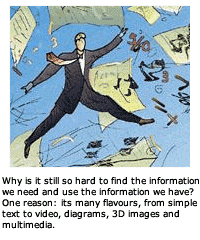How it Works: Information on demand

Searching for a baseball glove in an old, dark closet is nothing like finding a singing bird high up in a tree.

Different objects, different environments, different methods.
Likewise, at companies today different types of information reside in so many environments and in so many different formats that quickly extracting meaning from what you have is becoming almost impossible.

And itís only going to get worse, as emerging technologies such as pervasive computing and
RFID generate even more information and increase both the number of people who access
this information and their points of access.

Now imagine a company could look at all this information at once. Tap into all the structured and unstructured information without having to first convert it to a standard format. Analyze it and spot hidden trends before they occur, without humans having to digest it first. Recognize opportunities before they knock.
That's information on demand.

For example, in order for a company to attract and retain its best customers, it needs a precise portrait of who they are -- their wants, their needs, their buying patterns.
Using information integration tools, companies can paint that picture by analyzing and interpreting vast quantities of data --customer demographics, product-purchase histories, cross-sales, Internet experiences, online transactions, etc. -- turning information into insight and developing conclusive, fact-based strategies to gain a competitive edge.